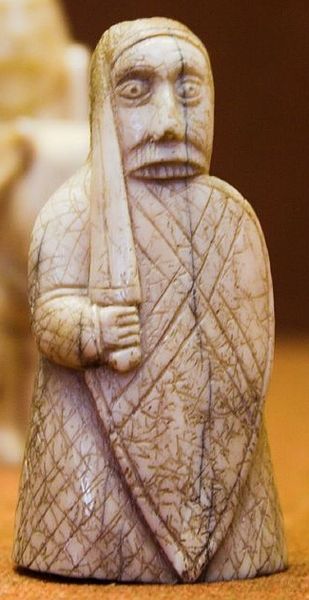In this post, I’ll be exploring the fascinating world of Viking Age Berserkers and Ulfhednar. While they have some differences, both were elite warriors steeped in myth and legend. Known for their unparalleled ferocity, these warriors have left a lasting impact on Viking culture and mythology. I’ll go through their origins, mythological abilities, and appearances in various sagas.
As we journey through the complex tapestry of Norse history and lore, we’ll uncover the stories behind these legendary warriors, exploring the line between fact and fiction. As far as possible I’ll include references to the primary sources that mention Berserkers and Ulfhednar. Hopefully, you will gain a deeper understanding of their roles in Viking society, much as I did researching this post.
Importance in Viking Culture and mythology
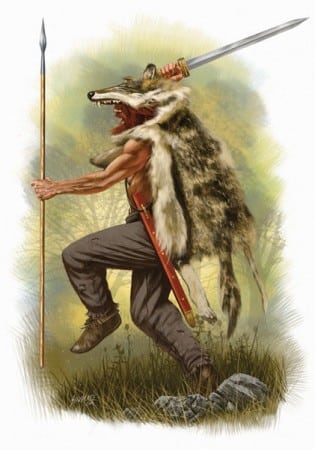
The significance of Berserkers and Ulfhednar in Viking culture and mythology cannot be understated. These warriors were highly esteemed for their fearsome abilities, especially in the earlier part of the Viking Age. However, while they might have been seen as the epitome of bravery and strength at some point, “berserkergang” (going berserk) was literally outlawed in the 12th and 13th century in both Iceland and Norway.
Their legends have greatly influenced our modern perception of Viking warriors, and they remain an enduring source of fascination in popular culture. In addition to their impact on our understanding of Viking culture, the stories of Berserkers and Ulfhednar have had a broader influence on the way we perceive warrior archetypes in general.
These tales have become a part of our collective consciousness, shaping the way we view heroism, strength, and the thin line between man and beast.
In the beginning though, as the Viking Age kicked off and they started raiding, Berserkers and Ulfhednar surely made an impression. From the Viking western expansion to Great Britain and France to their eastern expansion into the rivers of Eastern Europe and all the way down to Constantinople. From descriptions of the famed Varangian guard we might deduce that some of its members were indeed berserkers. The reverence for wolves can also be found in the many Viking age female names, and male names with Ulf in them. The image of battle-crazed Viking warriors was something their unwitting victims were wholly unprepared for.
Origins and Etymology
To begin, I want to try and draw a distinction between these two types of warriors. To be honest, though, I’m unsure of how real any distinctions are. Other than mainly being associated with either bears or wolves, I feel they inhabit most of the same characteristics.
Berserkers were known for their uncontrollable fury in battle, described as entering a trance-like state that made them seemingly impervious to pain. As a result, they were believed to possess supernatural strength and endurance, making them formidable adversaries. Ulfhednar, on the other hand, were warriors who donned wolf skins and were said to embody the ferocity of wolves in combat, granting them enhanced fighting skills and an animalistic edge.
While Berserkers and Ulfhednar shared some (many?) similarities, such as their ferocity in battle, they were distinct in their attire. Berserkers, as previously mentioned, wore bear skins, while Ulfhednar wore wolf skins. This distinction is important to keep in mind as we delve further into the sagas and myths that mention these warriors.
They are distinct through the myths, but why it is so sort of puzzles me. There might have been some other meaning or allegiance to a given god that is lost to us now.
The meaning of Berserker and Ulfhednar
Examining the etymology of the terms “berserker” and “ulfhednar” can provide further insight into their origins. The word “berserker” is derived from Old Norse “berserkr,” which is believed to mean “bear-shirt” or “bear-coat” (referring to the bear skins they wore). This etymology emphasizes the connection between the Berserker and the bear, both in terms of physical strength and the animalistic nature often attributed to these warriors.
Similarly, the term “ulfhednar” originates from Old Norse “úlfhéðinn,” which translates to “wolf-coat” or “wolf-hide.” This term clearly highlights the relationship between Ulfhednar and the wolves they emulated, further reinforcing the notion that these warriors channeled the spirit and ferocity of their respective animals in battle.
Connection to Odin, the chief Norse god
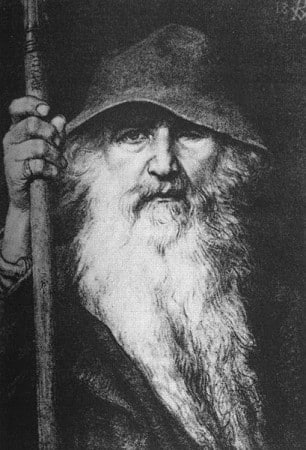
The etymology of Odin, the chief Norse god, offers valuable insights into the connection between this powerful deity and the fierce warriors known as Berserkers and Ulfhednar. Odin’s name is derived from the Old Norse word “Óðinn,” which in turn comes from the Proto-Germanic “*Wōđanaz.” This term is connected to the Proto-Germanic word “*wōđuz,” meaning “frenzy” or “rage,” and is also related to the Old Norse word “óðr,” denoting poetic inspiration or intense mental activity.
This etymological link highlights Odin’s association with the heightened emotional states experienced by Berserkers and Ulfhednar during battle, as well as the god’s role as a patron of warriors and poets alike.
Odin’s strong bond with these warrior types is further emphasized by his companionship with the two wolves, Geri and Freki. As warriors who entered a state of frenzied rage in combat, Berserkers and Ulfhednar were seen as embodying the fierce aspects of Odin. The Berserkers, with their bear associations, and the Ulfhednar, with their wolf connections, were believed to channel the primal strength and ferocity of these animals.
This made them fitting representatives of Odin’s own fierce and untamed nature, mirrored in his close relationship with Geri and Freki. The etymological and conceptual connection between Odin and these legendary warriors highlights their strong bond in Norse mythology and society.
Odin’s spells leaving Berserkers invulnerable
Both in the myths, and likely on the battlefield, the Berserkers acted like they were invulnerable and that weapons wouldn’t harm them. I’m going through mentions in myths further down, but part of a passage from the Ynglinga saga is interesting.
“…they killed men, but neither fire nor iron affected them. This is called going berserk.”
In the Poetic Edda poem Hávamál, Odin gives a list of magical spells he knows. From the description of the Berserkers in battle, it would seem they were under these spells, or at least believed it wholeheartedly.
150. For the third I know, if I have great need to restrain my foes, the weapons’ edge I deaden: of my adversaries nor arms nor wiles harm aught.
158. For the eleventh I know, if I have to lead my ancient friends to battle, under their shields I sing, and with power they go safe to the fight, safe from the fight; safe on every side they go.
I am not necessarily saying that Odin’s spells would work, but surely, his followers believed they did. In that frame of mind, with adrenaline surging through your veins as you are about to go into battle, the Berserkers might both feel and seem invincible.
Berserkers vs Ulfhednar
Berserkers and Ulfhednar shared the ability to undergo transformation or shapeshifting. This enabled them to channel the power and ferocity of their respective totemic animals. For Berserkers, this phenomenon is referred to as “berserkergang.” It involved entering a trance-like state, granting them immense strength and a fearless demeanor.
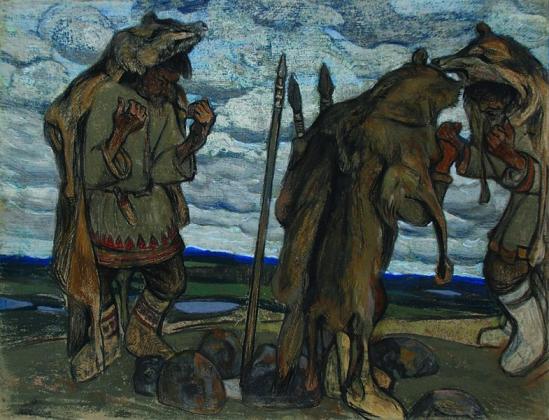
This transformation was closely tied to their bear-like qualities. Some sagas suggest they could physically become bears, while others implied they took on the animal’s traits and abilities without a literal transformation.
On the other hand, Ulfhednar’s transformation was associated with the wearing of wolf skins, which allowed them to adopt the characteristics and fighting prowess of wolves. While not necessarily a literal shapeshifting into wolves, at least one saga maintains that belief.
This transformation, metaphorical or not, imbued them with an animalistic ferocity, setting them apart from the Berserkers and their bear-like attributes.
Enhanced Powers and Ferocity
Both Berserkers and Ulfhednar were believed to possess incredible powers and ferocity as a result of their transformations. Berserkers displayed enhanced strength and endurance, which allowed them to dominate the battlefield and survive injuries that would incapacitate others.
Their enhanced abilities were often attributed to their transformation, as well as their connection to Odin, making them nearly unstoppable forces in combat. The term “berserker” has come to describe someone who displays exceptional ferocity or intensity in any given situation.
In contrast, Ulfhednar were known for their extraordinary fighting skills and heightened senses, agility, and reflexes, making them formidable opponents on the battlefield. Their connection to the wolf further amplified their ferocity, allowing them to channel the animal’s relentless hunting instincts and viciousness in combat.
The unique combination of enhanced fighting skills and ferocity solidified the Ulfhednar’s reputation as elite warriors in Viking society. Moreover, it served as a lasting symbol of their prowess and a testament to the power of the wolf as a totemic animal in Norse culture.
Berserkers and Ulfhednar in Myths and Sagas
In this chapter, I’ll discuss key sagas and poems that feature these legendary warriors and examine their unique connections to the animal kingdom and their roles in the battles of the Viking era.
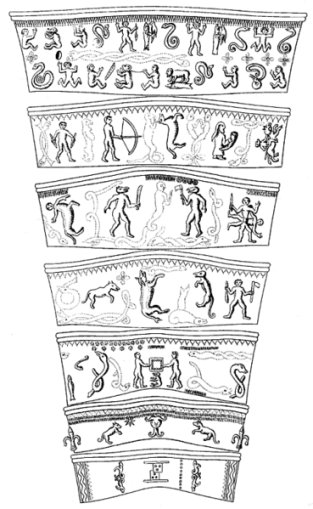
Ynglinga Saga – Berserkers as Odin’s elite warriors
The Ynglinga Saga, part of the Heimskringla, an Old Norse collection of kings’ sagas written by Snorri Sturluson, provides a fascinating glimpse into the role of Berserkers as Odin’s elite warriors. In this saga, Berserkers are described as the chosen warriors of Odin, who served him both in battle and as his personal guard.
The Ynglinga Saga recounts how these Berserkers, with their exceptional strength and ferocity, would strike fear into the hearts of their enemies. They were portrayed as near-invincible fighters, capable of overpowering any foe with their supernatural abilities. This saga highlights the special relationship between Berserkers and Odin, showcasing the reverence and awe they inspired in Viking society.
From Ynglinga saga ch. 6
Old Norse:
Óðinn kunni svá gera, at í orrostum urðu úvinir hans blindir eða daufir eða óttafullir, en vápn þeirra bitu eigi heldr en vendir; en hans menn fóru brynjulausir ok váru galnir sem hundar eða vargar, bitu í skjöldu sína, váru sterkir sem birnir eða griðungar; þeir drápu mannfólkit, en hvártki eldr né járn orti á þá. Þat er kallaðr berserksgangr.
English translation:
Odin could make it so, that in battles his enemies became blind or deaf or filled with fear, and their weapons bit no more than sticks; but his men went without armor and were mad as dogs or wolves, bit their shields, were strong as bears or bulls; they killed men, but neither fire nor iron affected them. This is called going berserk.
Hrolf Kraki’s Saga – Bodvar Bjarki’s berserker transformation
In the Hrolf Kraki’s Saga, another Old Norse tale, berserkers are quite central to the story. Not only are there berserker warriors, but one man is also transformed into a bear by a curse.
Berserkers are so central to the story, all their names are provided as well; Bödvar Bjarki, Beigaðr, Haklangr, Haki inn frækni, Harðrefill, Hjalti inn hugprúði, Hrómundr harði, Hrólfr skjóthendi, Hvítserkr inn hvati, Starólfr, Svipdagr, and Vöttr inn mikilaflaði.
This story demonstrates the power of the berserker transformation, showcasing how it could instill a warrior with incredible strength and the ability to overcome seemingly insurmountable odds. The tale of Bödvar Bjarki has become an iconic example of the Berserker myth, capturing the imagination of generations and contributing to our understanding of these legendary fighters.
Vatnsdæla Saga – Ulfhednar as a special class of warriors
In the Vatnsdæla Saga, we encounter Ulfhednar as a distinct class of warriors, separate from the more commonly known Berserkers. This saga emphasizes their unique abilities and the importance of the wolf-skin transformations in their identity as warriors. The Ulfhednar’s status as elite fighters is also evident in this saga, showcasing their prowess on the battlefield.
The Vatnsdæla Saga serves to illustrate the distinct nature of Ulfhednar and their role in Viking society. By recognizing them as a separate class of warriors, this saga helps to shed light on the broader spectrum of elite fighters in the Viking Age and their diverse connections to the animal kingdom.
Part of the Vatnsdøla Saga ch. 9
“After this, horns were blown throughout the entire army, and men prepared themselves, each according to their abilities. King Harald had the greatest part in this battle. With him were Rögnvald from Mæri and many other great chieftains, as well as those berserkers who were called úlfhéðnar.
They wore wolf pelts over their chainmail and guarded the bow of the king’s ship, while the king himself guarded the elevated platform with the utmost splendor and valor. Many blows, both large and small, could be seen there. Now, many events and great deeds occurred in a short time amidst the blows and spear thrusts, with grim stone-throwing.”
Haraldskvæði – Harald Fairhair’s Ulfhednar
The Haraldskvæði, also known as “Hrafnsmál,” meaning “Song of the Raven” is a skaldic poem. While it is not known for sure, the poem is generally attributed to the 9th-century Norwegian poet Þorbjörn Hornklofi.
In this poem, Harald Fairhair, the first King of Norway, is described as having a group of Ulfhednar among his warriors. These Ulfhednar were an integral part of Harald’s forces, contributing to his military successes and legendary status.
Below are stanza 20 and 21 from this poem as they are presented as a dialogue between a Valkyrie and a raven. With ravens closely associated with Odin, and him possibly taking the form of Huginn and Muninn, it’s fair to think this might be him in a raven form.
Excerpt from “Song of the Raven”
- ‘At berserkja reiðu vil ek þik spyrja,
bergir hræsævar:
hversu es fengit,
þeim es í folk vaða,
vígdjǫrfum verum?’ ‘‘I want to ask you about the equipment of berserks,
taster of the corpse-sea*:
what provision is made
for war-daring men,
those who surge into battle?’’
*this is a kenning for a raven. They were thought to come and pick at corpses after a battle, ie. the sea of corpses left behind.
- ‘Ulfheðnar heita,
þeir es í orrostu
blóðgar randir bera;
vigrar rjóða,
es til vígs koma;
þeim es þar sist saman.
Áræðismǫnnum einum,
hygg ek, þar undir felisk
skyli sá inn skilvísi,
þeim es í skjǫld hǫggva.’ ‘‘They are called wolf-skins,
who bear bloody shields in combat;
they redden spears
when they come to war;
there [at Haraldr’s court] they are seated together.
There, I believe,
he, the sovereign wise in understanding,
may entrust himself to men of courage alone,
those who hew into a shield.’’
Courtesy of the Skaldic Project
The inclusion of Ulfhednar in Harald Fairhair’s army demonstrates their importance as elite warriors during the Viking Age.
Völsunga Saga – Sigmund and Sinfjotli shapeshift into wolves
The Völsunga Saga, a legendary Old Norse saga, tells the story of the Völsung family, including the famous hero Sigurd. In one chapter of the saga, a man called Sigmund and his son Sinfjotli find wolf skins and put them on, causing them to transform into wolves. This transformation grants them the heightened senses, speed, and ferocity of wolves, which they use to their advantage while roaming the forest.
Saga of the Volsungs Ch. VIII
Now on a time as they fare abroad in the wood for the getting of wealth, they find a certain house, and two men with great gold rings asleep therein:
now these twain were spell-bound skin-changers, and wolf-skins were hanging up over them in the house; and every tenth day might they come out of those skins; and they were kings’ sons:
so Sigmund and Sinfjofli do the wolf-skins on them, and then might they nowise come out of them, though forsooth the same nature went with them as heretofore;
they howled as wolves howl, but both knew the meaning of that howling; they lay out in the wild-wood, and each went his way; and a word they made betwixt them,
that they should risk the onset of seven men, but no more, and that he who was first to be set on should howl in wolfish wise:
“Let us not depart from this,” says Sigmund, “for thou art young and over-bold, and men will deem the quarry good, when they take thee.”
While Sigmund and Sinfjotli’s transformation in the Völsunga Saga isn’t explicitly linked to the Ulfhednar, it shares a connection to the concept of wolf-skin transformations and the idea of adopting the traits and abilities of an animal. This story further highlights the importance of animal transformation and shapeshifting in Norse mythology and how these themes were woven into the legends of various warrior figures, including the Ulfhednar.
Berserker and Ulfhednar Fighting Techniques
Berserkers and Ulfhednar were known for their weapons and armor, or lack thereof. Normally, most Vikings wore chainmail and helmets for protection in battle. Berserkers and Ulfhednar however, often went into battle wearing little more than the animal skins associated with their transformation. This lack of armor allowed for greater mobility and was thought to be compensated for by their heightened strength and endurance.
As for weapons, Berserkers and Ulfhednar were known to wield a variety of implements, including axes, swords, and spears. However, they were also reputed to be capable of fighting with their bare hands or utilizing the natural weapons of their animal forms, such as the claws of a bear or the teeth of a wolf.
Psychological warfare and intimidation tactics
One of the key advantages Berserkers and Ulfhednar held over their enemies was their ability to instill fear and terror through psychological warfare and intimidation tactics. Their fierce reputations and supernatural associations made them figures of dread. Moreover, their presence on the battlefield could be enough to demoralize the enemy.
Some accounts describe Berserkers and Ulfhednar engaging in ritualistic displays before battle, such as the “berserker rage.” This would involve howling, growling, and other animalistic behaviors meant to intimidate their opponents. These displays served to heighten the warriors’ own aggression and focus, while also undermining the morale of the enemy forces.
Formation strategies and tactics
While the individual prowess of Berserkers and Ulfhednar was undoubtedly impressive, their true strength lay in their ability to work as a cohesive unit on the battlefield. They would often fight in specialized formations, one example being the “Svinfylking” or “boar’s snout.” It was a wedge-shaped formation designed to break through enemy lines and sow chaos in their ranks.
Heading up such a formation would be the Berserkers, probably scaring the living daylights out of their enemies. These tactics allowed Berserkers and Ulfhednar to maximize their impact on the battlefield and capitalize on their unique abilities.
Theories on the source of berserker rage
One of the enduring mysteries surrounding Berserkers and Ulfhednar is the source of their legendary rage and seemingly superhuman abilities. Growing up I was typically told that Vikings in general would eat a certain type of mushroom before going into battle. This mushroom, the fly agaric, would render them crazed and unstoppable. This is however a source for much debate and possibly only something done by berserkers.
The fly agaric mushroom is one possibility, but not the only one. There is another well-known possibility in the plant henbane. Indeed a number of archeological Viking Age finds have included seeds from the henbane plant proving this was a commonly known and used plant.
Henbane and its medicinal and psychoactive properties have been known for thousands of years, stretching back to the ancient Greeks. Below is a painting depicting the Colchian princess Medea, preparing a magical potion for Jason, of Jason and the Argonauts fame. This potion is said to contain henbane among other herbs.
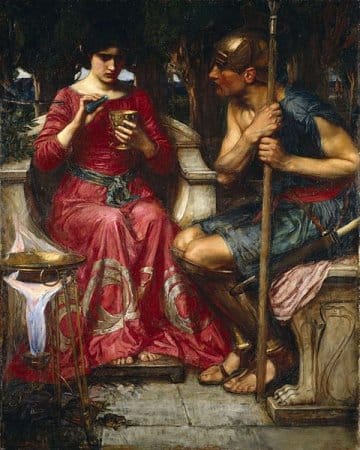
This topic has been a source for both research and much discussion for many years. Reading through some of it I do find that a lot of it comes across as too academic. It seems far removed from the plain reality of going into battle, and Viking Age society’s close relationship with nature. They lived in a magical world, Völva’s and no real boundaries between the natural and the supernatural. That they would embrace mind-altering and psychedelic herbs or mushrooms seems a given.
Hallucinogens, amphetamines and other psychoactive drugs were used voluntarily, and as experiments on soldiers in the 20th century. The idea that Vikings wouldn’t have embraced mind-altering and performance-enhancing drugs if they could seem improbable to me.
Berserkers and Ulfhednar in Viking Society
Much of our understanding of Berserkers and Ulfhednar comes from sagas and myths. However, there is also historical evidence and archaeological findings that suggest these warriors played a role in Viking society.
Excavations have unearthed amulets and carvings depicting figures in animal skins, which could be interpreted as representations of these warriors. Some of these artifacts, such as the Torslunda helmet plate and the Oseberg tapestry, provide a fascinating glimpse into how these warriors were perceived in their time.
Another great example is forever embodied in some of the pieces of the chess pieces known as the Lewis chessmen. Discovered in 1831 on the island of Lewis in Scotland, the whole find was almost one hundred chess pieces made from walrus ivory. Some of the rook pieces are obviously modeled on berserkers in the way they are biting their shield.
Additionally, written accounts from contemporary sources, such as the Anglo-Saxon Chronicle and various skaldic poems, provide further evidence of the presence of Berserkers and Ulfhednar in the Viking Age.
These sources lend credibility to the notion that these warriors were more than just figures of myth and legend. They were actual members of Viking society. The combination of archaeological and textual evidence helps paint a more nuanced picture of Berserkers and Ulfhednar. Moreover, it is grounding their stories in historical reality.
Later criminalization of the Berserkers
Interestingly, in the mid 13th century Icelandic law book Grágás, “going berserk” was criminalized. The law specifically prohibits berserksgangr, which is the practice of going into a berserker rage or frenzy. According to the Grágás, berserkers who engage in this behavior are considered outlaws and are subject to punishment.
In the section “Konungsbók” of the Grágás, there is a passage that states:
“Um þat mælti konungr: Þat eru vér sáttir at því, at þú komir aftr til handa mér skjaldar þann, sem þú brást í, ok skaltu þá hvarki bera né bita þann skjöld. Ok skaltu þá eigi fara í berserksgang meðan þú ert í þjónustu várra.”
The English translation is (somewhat) as follows:
“The king spoke about that: We are satisfied with the fact that you will return to me the shield you broke, and then you shall neither carry nor bite that shield. And you shall not engage in berserker rage while you are in our service.”
This passage highlights the prohibition of engaging in berserker behavior and implies that those who do so could face consequences. Moreover, they faced possibly being outlawed or facing other penalties.
Roles and responsibilities
Berserkers and Ulfhednar were valued for their combat skills, often serving as elite warriors during battles and raids. Their strength, ferocity, and seemingly supernatural abilities made them formidable adversaries. As a result, they were placed at the forefront of battle to maximize impact and inspire fellow fighters.
In addition to battlefield roles, Berserkers and Ulfhednar sometimes served as personal bodyguards for kings and chieftains. Their fierce reputations and loyalty made them ideal candidates for this prestigious position. Being a bodyguard provided opportunities to gain prestige and influence, further solidifying their status as elite warriors in Norse culture.
In several descriptions or on ancient artifacts, Viking warriors of the famed Varangian guard wore bear, or wolf-pelts. The Berserkers and Ulfhednar were possibly the fiercest of the Viking worriers. That some joined the ranks of the Varangian guard seems natural.
Last thoughts on Berserkers and Ulfhednar
The Berserkers and Ulfhednar have left a lasting impression on our understanding of the Viking Age and its warrior culture. These elite warriors played a significant role in the battles and mythology of the Norse people.
The stories found in various sagas and poems serve to illustrate the complex tapestry of beliefs and values that informed the Viking worldview, as well as the reverence for the forces of nature that shaped their society.
The lines between myth and reality may sometimes blur. However the enduring legacy of Berserkers and Ulfhednar continues to captivate and inspire us today. These legendary warriors serve as a testament to the power of the human imagination and our fascination with the extraordinary. The tales of Berserkers and Ulfhednar will remain an integral part of our understanding of this fascinating period in history.
FAQs
The primary distinction lies in their animal associations: Berserkers are connected to bears, while Ulfhednar are linked to wolves. This association influences their respective transformations, abilities, and fighting styles.
The concept of shapeshifting is more metaphorical than literal. These warriors adopted the traits and abilities of their associated animals, but there’s no concrete evidence that they physically transformed.
While they were considered elite warriors, their presence in Viking armies was likely less common than popularly portrayed. They were more often found serving as bodyguards for kings and chieftains.
Both Berserkers and Ulfhednar were considered to be favored by Odin, the chief Norse god. Their animal transformations, fighting prowess, and ferocity were thought to be divine gifts from Odin.
They generally used typical Viking weapons, such as swords, axes, and spears. However, they were known to fight without armor, relying on their enhanced abilities and ferocity for protection.
Several theories and finds in Viking burial sites suggest the use of hallucinogens or alcohol to trigger the berserker rage. This was likely used in combination with psychological and cultural factors.
Featured Image Credit: Knut Stjerna (1874-1909), Public domain, via Wikimedia Commons

